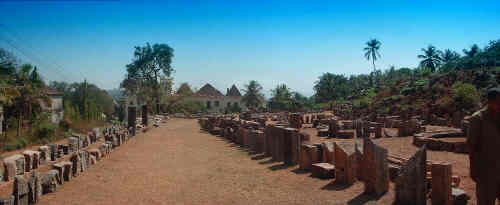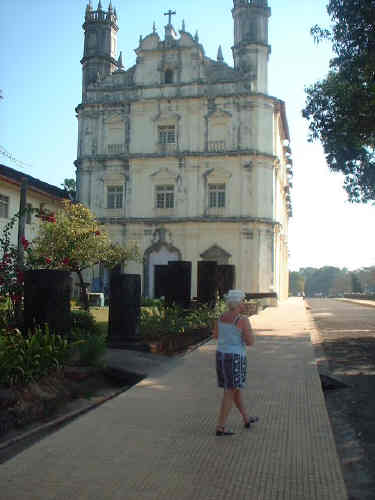|

|
 |
|
ST FRANCIS OF ASSISI
|
SE CATHEDRAL
|

|
|
The construction of most of
the churches at Velha Goa was started when the Renaissance
in Europe was heading towards a transformation into
Baroque. The salient features like twisted shafts, broken
cornices surrounded by curved pediments, wavy scrolls,
flying figures with a touch of Classic orders and profuse
interior decorations with intricate details of
ornamentation emphasized by gilding in gold were followed
in the construction of churches in Goa.
|
|

|
SE CATHEDRAL
The SE Cathedral (1562 – 1652) is the largest
church, characterised by its Tuscan exterior, Corinthian columns
at its portals with triangular pediments and the barrel – vault
over the naïve. The church had two towers out of which one
collapsed in 1776. It has eight chapels and six alters, while
the main alter is dedicated to St Catherine of Alexandra. There
is a reflection of Baroque tradition in wooden alters.
|

|
 |
|
The church of Our Lady of
Grace popularly known as St Augustine Church (1602) is situated
on the Holy Hill. The Augustinian Order established their
convent in 1572. Later on the college of Populo was added to it
in 1602. It was the largest church complex with seminary,
convent, library cloisters, dormitories, galleries and number of
cells as quoted of by many a travellers as to the grandeur of
this Church. The façade of the church had four stories with
three arched doorways flanked by Corinthian columns and two
lofty bell towers (46 m in height) on either side. |
 |
|
The Portuguese Government
banned all the religious orders in 1832 and by 1835 all the
Augustinians were forced to leave Goa. As there was no
maintenance the huge vault of the church collapsed in 1842. Its
façade and towers fell down in 1931 and 1938.
The Archaeological Survey of
India removed the collapsed debris and brought to light the five
alters, eight side chapels and a cloister. The interior of the
church is profusely decorated with glazed tiles.
|
|
 |

|
CHURCH AND CONVENT OF
|
|
ST FRANCIS OF ASSISI
|
|
|
The church of Holy Spirit popularly known as
the church of St Francis of Assisi was built in 1517. Later on
it was rebuilt twice, first in 1521 and finally in 1661. The
ornamental portals of the church are in Manueline with trefoiled
arch. The four storied façade has two octagonal towers
crowned with balustrades and pinnacles on both sides. The
reminiscent of Gothic rib vaulted naive that has no aisles
alongside is provided with six chapels and two alters. |
 |
|
The main alter has Baroque
with Corinthian features. On either side of the main
alter, there are beautiful large wood panels in oil paintings,
depicting scenes from the life of St Francis of Assisi. |

|
BASILICA OF BOM JESUS
|
|
The church (1594-1605 AD) has a main alter, four side alters,
two chapels, a sacristy and a choir. The richly carved
main alter is dedicated to the infant Jesus. It's facade
decorated with Ionic, Tuscan, Corinthian and Composite pillars
and pilasters, shows application of classical Orders. The added
attraction of this church is the chapel containing the relics of
the body of St Francis Xavier. |
 |
|
The Florentine sculptor Giovanni Batista Foggini made the marble tomb of the saint in 698 at the
order of the Duke of Tuscany Cosmas III. The rich silver casket
containing the relics of St Francis Xavier, was wrought by Goan
silversmith in 1636-37. |

|
CHAPEL OF ST CATHERINE
The chapel of St Catherine first built in 1510
immediately after the conquest of Goa, in honour of St
Catherine, was later on repaired in 1550 by the Governor George
Cabral and still later reconstructed in 1952. It has two short
towers on either side of the façade and an alter in the
interior. It was raised to the status of the Cathedral by Pope
Paul III by a bill issued in 1534 and maintained the position
till the new Cathedral was constructed.
|

|
 |